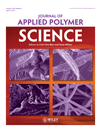Poly(para-dioxanone)/poly(D,L-lactide) blends compatibilized with poly(D,L-lactide-co-para-dioxanone)
Abstract
The effect of poly(D,L-lactide-co-para-dioxanone) (PLADO) as the compatibilizer on the properties of the blend of poly(para-dioxanone) (PPDO) and poly(D,L-lactide) (PDLLA) has been investigated. The 80/20 PPDO/PDLLA blends containing from 1% to 10% of random copolymer PLADO were prepared by solution coprecipitation. The PLADO component played a very important role in determining morphology, thermal, mechanical, and hydrophilic properties of the blends. Addition of PLADO into the blends could enhance the compatibility between dispersed PDLLA phase and PPDO matrix; the boundary between the two phases became unclear and even the smallest holes were not detected. On the other hand, the position of the Tg was composition dependent; when 5% PLADO was added into blend, the Tg distance between PPDO and PDLLA was shortened. The blends with various contents of compatibilizer had better mechanical properties compared with simple PPDO/PDLLA binary polymer blend, and such characteristics further improved as adding 5% random copolymers. The maximum observed tensile strength was 29.05 MPa for the compatibilized PPDO/PDLLA blend with 5% PLADO, whereas tensile strength of the uncompatibilized PPDO/PDLLA blend was 14.03 MPa, which was the lowest tensile strength. © 2010 Wiley Periodicals, Inc. J Appl Polym Sci, 2011




